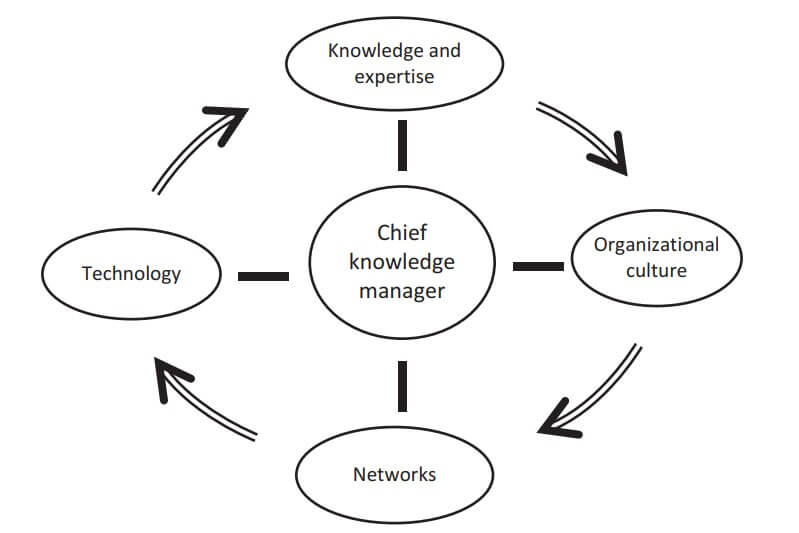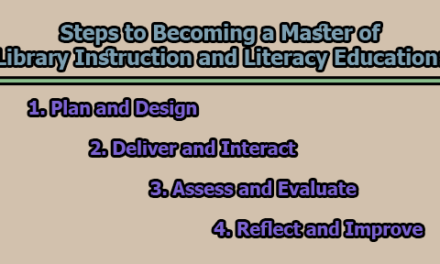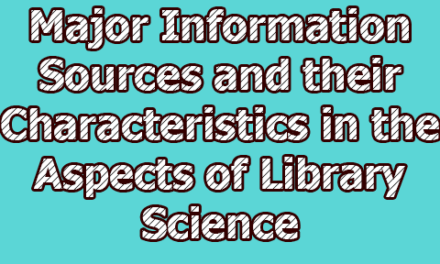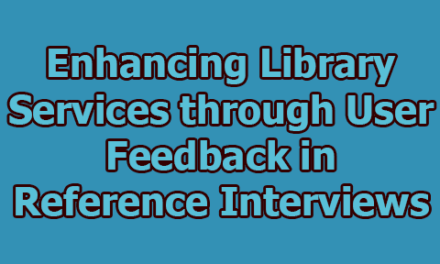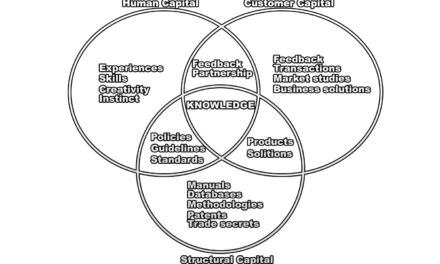Knowledge Management Strategy for a Library
Knowledge is recognized as a critical resource for sustaining competitive advantage, learning new skills, solving problems, and developing competencies. Knowledge management (KM) has become an important issue within all kinds of organizations. Organizations implement KM to optimize various types of knowledge resources and maximize their strategic value. If done properly, it can provide tremendous value-added benefits to an organization. In this article, we are going to present Knowledge Management Strategy for a library.
Definition of Knowledge Management:
There are several definitions are being in the term knowledge management which all are not equally necessary, some of the notable definitions are given below;
“Knowledge management (KM) is the collection of methods relating to creating, sharing, using, and managing the knowledge and information of an organization. It refers to a multidisciplinary approach to achieve organizational objectives by making the best use of knowledge.” (Wikipedia)
“Knowledge management is a discipline that promotes an integrated approach to identifying, capturing, evaluating, retrieving, and sharing all of an enterprise’s information assets. These assets may include databases, documents, policies, procedures, and previously un-captured expertise and experience in individual workers.” (KM World)
“The knowledge management (KM) category represents solutions that streamline the process of capturing, distributing, and effectively using knowledge. When an organization is able to easily access, share, and update business knowledge, it can become more productive and cost-efficient. The ability to access the right knowledge at the right time, via a robust knowledge management system, informs accurate decision-making and stimulates collaboration and innovation.” (Get Guru)
“Knowledge management (KM) is the interdisciplinary process of creating, using, sharing, and maintaining an organization’s information and knowledge. It is a multi-faceted strategy for making the best use of organizational knowledge assets in order to achieve business objectives such as enhancing competitive advantage, improving performance, boosting innovation, sharing insights, and continuously improving the organization.” (Omni.sci)
From the above definitions, we can say that Knowledge management is the process by which an enterprise gathers, organizes, shares, and analyzes its knowledge in a way that is easily accessible to employees. This knowledge includes technical resources, frequently asked questions, training documents, and people skills.
Categories of Knowledge Assets in a Library:
Knowledge in academic libraries may be classified into four categories: Tacit Knowledge, Explicit Knowledge, Procedural Knowledge, and Cultural Knowledge which are briefly described below;
i. Tacit Knowledge: is a kind of personal knowledge that is learned by members of an organization through experience and learning by doing, and is used to perform their work. It contains mental models, perceptions, insights, assumptions, personal beliefs, subjective insights, intuitions, instincts, and values. There are two dimensions of tacit knowledge which are the technical dimension (which encompasses the kind of informal and personal skills often captured in terms of “know-how” is demonstrated when people master a specific body of knowledge or use skills) and the cognitive dimension (which consists of beliefs, perceptions, ideas, values, and emotions).
ii. Explicit Knowledge: expressed formally using a system of symbols, and can therefore be easily communicated or diffused, intellectual assets are valuable to an organization because it adds to the organization’s observable and tradeable stocks of knowledge. Explicit knowledge serves three important purposes in an organization which are;
- It encodes past learning in artifacts and rules;
- It facilitates coordination between disparate activities and functions in the organization; and
- It signifies technical skill and procedural rationality, and so helps the organization to present a self-image of competence, legitimacy, and accountability.
A library’s explicit knowledge includes collection development policies, collection guides, conference proceedings, formal educational credentials, frequently asked questions, information standards, presentations, professional publications, reading lists, webinars, and workshops. Two types of explicit knowledge in an academic institution: internal explicit knowledge (consists of reports, guidelines, theses, databases, minutes of meetings, and any other type of tangible knowledge containers generated within the university) and external explicit knowledge (encompasses tangible material in the form of books, journals, reports, CD-ROMs, and any other media produced outside the university).
iii. Procedural Knowledge: is an understanding of how to do a task or carry out a procedure. It consists of step-by-step procedures for handling various tasks of explaining various occurrences. Examples of procedural knowledge in the context of a library include acquisitions and selection knowledge, budgeting knowledge, cataloging knowledge, circulation knowledge, facilities management knowledge, information-finding strategies, knowledge of information sources, literacy training knowledge, personnel management knowledge, etc.
iv. Cultural Knowledge: is an organization that consists of the beliefs that are held to be true based on experience, observation, and reflection about itself and its environment. Cultural knowledge in a library includes collaborative, community-oriented, fair rewards and recognitions, service orientation and attitude, learning culture, mentoring and coaching culture, open-mindedness, being open to different types of learning experiences, being open to experimentation, and strong community culture.
Strategy to Manage Knowledge in Libraries:
KM strategy helps an organization to develop a road map that can be used to identify and prioritize KM initiatives, tools, and approaches in such a way as to support its long-term business objectives which helps to address the following questions:
- Which KM approach, or set of KM approaches, will bring the most value to the organization?
- How can the organization prioritize alternatives when any one or several of the alternatives are appealing and resources are limited?
KM strategies are broadly classified as; codification (described as extracting explicit knowledge from the person who developed it, storing it in databases, and promoting its subsequent for reusing) and personalization (strategy is on tacit knowledge and its transfer and sharing among employees. It requires investment in building networks of people, where knowledge is shared not only face to face, but also virtually over the telephone, by e-mail, and via video-conferencing).
Academic libraries have long been described as the heart of their universities because of the strategic position they occupy. They were established to support the mission of the universities by providing resources to aid teaching, learning, and research. The environment in which academic libraries operate today and the way people search and access information has changed due to the rapid developments in information and communication technologies (ICT). Development of the Internet, the World Wide Web, user-friendly databases, and search engines have not only made a profound impact on the structure and functioning of academic libraries but also has challenged the status of academic libraries as the only provider of information. This is because of the alternatives, such as Google Scholar, that are available for people to locate and access scholarly literature from commercial publishers. Technological changes, along with the external pressure of market forces, have forced academic libraries to transform their structures and implement new managerial processes.
Key Components of KM Strategy:
KM strategy has three critical components which are briefly described below;
a. People: people and culture; these address the “mindset” and relate to attributes of assessing people and culture. Explicit knowledge in an organization can easily be identified, acquired, organized, stored, and transferred. To manage explicit knowledge, organizations must:
- generate, create, or acquire knowledge;
- codify and organize knowledge to facilitate easy access;
- make knowledge available to others through communication or publications;
- facilitate access to, and retrieval of, knowledge; and
- use and apply knowledge to solve problems, support decisions, improve performance, coach, and analyze situations and processes to support business activities.
b. KM process: process and strategy; these facilitate and guide the efforts of the people to capture and use the knowledge in the organization to achieve business benefits. It consists of the following steps:
- identification of knowledge needs;
- the assessment of existing knowledge resources and services;
- acquisition of new knowledge in order to accomplish the knowledge needs;
- integration of new knowledge and services;
- modification of the existing system;
- replacing outdated knowledge;
- evaluation of knowledge;
- continuous improvement; and
- providing knowledge in the best possible way to all members of the community.
The knowledge processes introduced above are briefly described below;
Knowledge Identification and Acquisition: The following types of knowledge may be useful for librarians in libraries:
- knowledge of a specific job or task, for example, how to do reference work;
- a list of a subject- or task-level experts who have the best qualifications, the latest training, or the expertise to best perform certain jobs/tasks;
- a list of experts who can solve particular types of problems that have the potential to reoccur;
- knowledge of historical precedents—have certain processes been tried before and what was their outcome;
- knowledge of users and competitors; and
- knowledge about creating successful project teams—knowing who has the skillsets for similar projects and who has worked together successfully in the past.
They are also expected to acquire knowledge continuously from different sources to keep them updated. Knowledge in libraries can be acquired through:
- establishing knowledge links or networking with other libraries and with institutions of all kinds;
- attending training programs, conferences, seminars, and workshops;
- subscribing to list serves and online or virtual communities of practice; and
- buying knowledge products or resources in the form of manuals, blueprints, reports, and research reports.
Knowledge is also acquired indirectly by writing down the answers to the following questions:
- What do you know about your strengths?
- What are the strengths, weaknesses, values, and ambitions of others with whom you work?
- How would you approach a similar job differently in the future?
Knowledge Capture and Codification: knowledge capture “involves the key inputs and outputs of knowledge. The codification of knowledge provides several benefits to libraries:
- Codification enables libraries to secure knowledge. A library is in less danger of losing its intellectual assets, even when its employees retire or leave the organization.
- Codification enables fast access and retrieval of knowledge.
- Codification facilitates sharing, reuse, reflection, and ongoing learning.
The following steps in the codification and representation of knowledge:
- Identifying, acquiring, or extracting valuable knowledge from documents, discussions, or interviews, usually accomplished with the help of subject matter experts.
- Refining, writing up, and editing; raw knowledge and turning it into processed knowledge.
- Organizing the processed knowledge and making it accessible by adding index terms, subject headings, cross-reference links, and metadata.
- Packaging, publishing, and disseminating knowledge through a variety of channels, including intranet web pages, CD-ROMs, subject-oriented pathfinders, and “knowledge portals” that are focused on particular business needs or issues.
- Designing and managing the overall information architecture consisting of a set of well-defined standards and schemes for organizing, classifying, publishing, and navigating the organization’s intellectual content.
Knowledge Organization and Retrieval: Knowledge organization and retrieval refers to the processes of “knowledge structuring and storing that make it more formalized and accessible.” These processes focus on developing systems to systematically capture, record, organize, and store the key inputs and outputs of knowledge, and to find, collect, and organize internal knowledge and best practices.
Knowledge Transfer and Sharing: The transfer of knowledge encompasses activities and processes associated with the flow of artifacts from one agent to another. Sharing knowledge is the process whereby individuals mutually exchange explicit and tacit knowledge and jointly create new knowledge.
Knowledge Use and Application: Knowledge application is the process of incorporating knowledge into an organization’s products, services, and practices to derive value from it. Employees use and apply this knowledge to improve performance and generate new knowledge in the process.
c. Information technology: information technology infrastructure; this is an enabler that helps people harness the maximum out of KM initiatives. The most common applications of IT-based tools in academic libraries include:
- communication tools such as e-mail, instant messaging, telephones, teleconferencing, intranets, video-conferencing, etc.;
- long-standing tools such as databases, institutional archives, etc.; and
- social media tools such as wikis, blogs, online communities, and social networking sites.
Some examples of ICT that can enhance or support KM initiatives are listed below:
- video-conferencing/telephone
- groupware; an example is Lotus notes
- intranets/Internet
- portals
- expertise location
- electronic bulletin boards
- knowledge directories
- databases
- electronic mails
- intelligent search engines
- blogs/Facebook/Twitter
Knowledge management Model for Libraries:
An attempt is made to outline the elements of the proposed model to formulate some basic steps which may be followed as the starting point in the implementation of KM in academic libraries. The proposed model is composed of five elements which are briefly given below;
A. Knowledge and Expertise: The fundamental element of the proposed model is the requirement of professional competencies. Professional competencies based on activities such as knowledge organization and preservation, information search, retrieval and dissemination, the creation of information products and services with added value constitute essential organizational assets of academic libraries. Therefore firstly academic libraries should identify and focus on those few processes which they do best, developing and improving them all the time. Through a variety of mechanisms of organizational learning, academic libraries can create, collect, and use the knowledge necessary for these processes. Based on this knowledge, they can develop new operating procedures and improve the existing ones. Organizational learning is essential for developing professional competencies and it must be fostered and enhanced continuously.
B. Organizational Culture: The second element of the proposed model is the people, the human resources, and the organizational culture. Organizational culture (including aspects such as communication, organizational learning, knowledge sharing, and communities of practice) is a fundamental element of the KM process. The chances of success in the implementation of KM are almost absent in any kind of organization, including libraries, without the development of a collective culture open to change. For increased efficiency in KM in academic libraries, learning, creativity, and quality should be valued and sought, the acquisition of new skills and knowledge must be an ongoing process, investment in human resources and the further training of employees should be made. Communities of practice should be encouraged. An online discussion forum may be created, which may help to improve the processes of organizational learning, sharing of knowledge, and expertise. Appropriate measures must be taken by librarians so that knowledge sharing takes place, perhaps leading to the establishment of organizational changes to encourage greater use of this forum. A system must be set up for periodic evaluations and rewards to encourage people to contribute their knowledge and to use the knowledge of others.
C. Information Technology Infrastructure: The third element of the proposed model is technology, which can underpin the process of KM by improving the methods of organizational learning and knowledge sharing. Technology plays a fundamental role in creating a culture and an infrastructure to stimulate and enable access to knowledge and expertise exists in the organization. KM systems based on advanced technologies may collect the relevant knowledge and experience in an organization and may make it available anywhere and anytime, thus supporting the process of decisions that are made within the library. KM systems support the processes of identification and codification of knowledge, sharing, and distribution of knowledge, and also the processes of creation of new knowledge and integration of this into the organization. With these systems, knowledge can be preserved in the organizational memory for the training of future employees and for helping them in making decisions. Technology-based systems can also connect academic libraries to external sources of knowledge. With the help of these systems, people having expertise in specific areas can be located and a knowledge directory can be created. This knowledge directory can help people: (i) contact specific areas of expertise, (ii) get in touch with those who possess knowledge, and (iii) easily identify experts and share knowledge with them.
D. Networks: The fourth element of the proposed model network, such as the partnerships with other public or private organizations and libraries. Networks and collaboration represent a solution for extended access to knowledge for more creative uses and for increased quality of the processes and services. Academic libraries should be organized in networks, with all the human, information, knowledge, and technology resources they possess. This will provide an opportunity for academic libraries to use human knowledge productively, and thereby make academic libraries more efficient and competitive. Also, as part of a network, academic libraries are able to focus on creating and improving the facilities and infrastructure that encourage and support learning. Through partnerships and networks, academic libraries have more knowledge assets, which ultimately improve overall library functions and services.
E. Creation of the Position of Knowledge Manager: The last element of the proposed KM model is the creation of the position of a knowledge manager in academic libraries. The creation of a knowledge manager position appreciably increases the chances of success in the implementation of KM in academic libraries. Knowledge managers will coordinate the technological infrastructure, human resources, the processes of creation, the use and sharing of knowledge, and the cooperative relationships of the organization. This model will help academic libraries in the implementation of KM through the:
- identification of the most important processes, products, and services of academic libraries, and their evaluation;
- identification of knowledge resources and skills in the organization in order to exploit these resources; and
- identification of potential external partners for collaboration.
The proposed model places the knowledge assets of the organization at the organizational level to support the expansion and improvement of the main activities deployed by academic libraries:
- the acquisition, organization, processing, and preservation of documents;
- information search and retrieval;
- information dissemination;
- development of information processes and services;
- provision of information services for users, etc.
Finally, we can say that the process of KM implementation starts with the internal analysis of the organization to identify its main activities, operations, and most requested services. The next step in the process of KM implementation is the identification of relevant skills, competencies, and knowledge, which are the basis of carrying out different operations and providing services. Once the relevant and appropriate skills, competencies, and knowledge are identified, they must be put into action through the application of appropriate KM tools and techniques. If relevant skills, competencies, and knowledge are not available internally in the organization, they must be acquired, developed, and improved through the process of organizational learning. Additionally, an organizational culture, which is open to change and favorable in terms of organizational learning, knowledge sharing cooperation, and teamwork, is essential for better communication at the organizational level. Finally, a well-defined KM strategy needs to be formulated in order to integrate the essential components of a KM system, that is, people, processes, and information technology. The success or failure of KM implementation largely depends on systematically integrating these three basic pillars of KM, as they are recognized as the key foundation areas of KM. Formulation of a well-planned KM implementation strategy is one of the important steps in the KM implementation process, as it leads the whole organization towards achieving a successful KM implementation and allows it to stay competitive. The KM strategy should be rooted in and guided by an understanding of the nature and types of organizational knowledge so that it can tell us what works, what matters, what we should trust, where things can go wrong, and how we can fix them.
References:
- Dalkir, K., 2005. Knowledge Management in Theory and Practice. Elsevier Butter worth Heinemann, Burlington, MA.
- Davenport, T.H., Prusak, L., 2000. Working Knowledge: How Organizations Manage What They Know. Harvard Business School Press, Boston, MA.
- Du Plessis, M., Boon, J.A., 2004. The role of knowledge management in e-business and customer relationship management: South African case study findings. Int. J. Inf. Manag. 24 (1), 73–86.
- Frost, A., 2010. The different types of knowledge. Available at: http://www.knowledge- management-tools.net/different-types-of-knowledge.html (accessed 14.12.15).
- Gandhi, S., 2004. Knowledge management and reference service. J. Acad. Librariansh. 30 (5), 368–381.

Library Lecturer at Nurul Amin Degree College

